The Christ Figure in Film: The Passion of the Christ and Man of Steel
As viewers, we require a sacrificial hero with salvational purpose, who will overcome trials and tribulations, bearing our suffering as their own. This is exemplified in figures like Jesus, who appears frequently on film in many forms besides his own, and the superhero Superman. Jesus Christ, according to the religious teachings, was God incarnate, and suffered for the sake of the human soul. In a more modern occurrence, Superman becomes the Christ figure, with the same hopes and desires for humankind and our salvation. They have a compelling love for humankind, so much that they are willing to give their lives for our benefit. But the human trust in the hero is solidified only when the hero is willing to die for us. A selfless hero evokes passion and a connection in the viewer, and because of this sacrifice, the hero becomes someone we can sympathize and identify with.
Humanity has re-told and re-adapted these stories for decades, and the times in which they are adapted are significant in understanding the human need for a hero to lead them when it seems hope has been lost. Through the re-telling of these stories, it can be said that humanity has need for a sacrificial hero who will walk among us and willingly die for our salvation, as if their sacrifice depends on our survival. In Jesus in the film The Passion of the Christ (2004), Superman in the film Man of Steel (2013), these heroes represent a utopian ideal that the viewer hopes, through repetition, can make a better world.
The Meaning of Jesus and His Sacrifice

Before delving into the representation of the Christ figure in The Passion of the Christ and Man of Steel, it will benefit us to start with the Christ figure as seen in the New Testament Bible, who, through his example, inspired a religion which flourishes still today. His life and death is mainly present in the Gospels Matthew, Mark, Luke, and John. Jesus is a central figure in the Christian faith, and he is held in that faith as the Son of God and the Messiah. According to the Bible, he is born in Nazareth of Mary and Joseph, and is destined from the very moment of his birth to die for the sins of man. After he is baptized and overcomes temptation, Jesus travels and performs miracles to assert his divinity. When his disciple Judas betrays him, Jesus is arrested and condemned by a Jewish judicial group and the Roman governor Pontius Pilate. He is then crucified and dies. After the first day of the week after the crucifixion, his tomb is empty, as he has been resurrected from the dead.
The first question that the Christian faith has to answer is: why did humanity need Jesus? Jesus is constantly proclaimed throughout the Bible as the redeemer and savior of our souls. In the Bible, the archangel Gabriel proclaims to Joseph, Mary’s husband, that “‘…she [Mary] will bring forth a Son, and you shall call His name Jesus, for He will save His people from their sins’”(Matthew 1:21). The archangel Gabriel proclaims from the very start, the annunciation of Jesus, that he is destined to save his people from their sins. According to Christian theology, Jesus was needed for many reasons—the first is because of the fall of humankind in the garden of Eden. Because God gave Adam and Eve free will, their one imperfection was sin. In Genesis 3:1-4, they ate the fruit of the tree of knowledge of good and evil, which lead to them being cast out of paradise to live as mortals on earth. Because of the first sin, Jesus had to be born because humanity became cut off from God. Without the sacrifice, humanity was doomed, with no hope after death. Jesus had to pay the penalty for their sins through his own death, as the sacrificial lamb, and his resurrection demonstrates the promise of the ascension of our own souls. According to Christian theology, Jesus was also needed so that humankind would have someone to believe in—a hero that they could follow and identify with. This hero has endured for centuries, and Jesus has become a figure to idolize and strengthen the believer. The Christ figure, in many ways, has become the essence of the hero, and has transcended into film.
The Passion of the Christ: The Humanity of Jesus
The film The Passion of the Christ depicts Jesus as a hero that humankind can follow and identify with, because Jesus is shown with compelling humanity. The film is centered around his selfless sacrifice for the good of humankind. Directed by Mel Gibson and starring Jim Caviezel as Jesus Christ, it depicts Jesus according to the New Testament Gospels of Matthew, Mark, Luke and John. Centered around the final 12 hours of Jesus’ life, the film begins with his temptation in Gethsemane, moving to his torture and death, and ending with his resurrection.
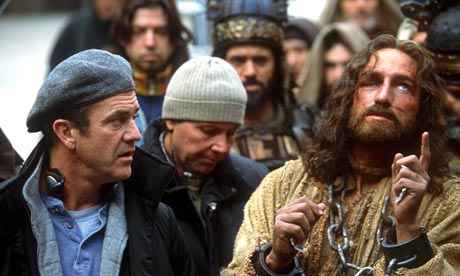
The film opens with a Bible passage: “He was wounded for our transgressions, crushed for our iniquities; by His wounds we are healed,” (Isaiah 53). In this passage, Gibson is addressing this question: why would God allow him to die? This Bible verse explains that Jesus suffered on the cross so that humankind could have hope. Through his wounds, humankind is healed. Jesus took human suffering as his own. This is why Gibson’s adaptation of the Christ figure is significant in understanding the sacrifice—Jesus died a violent death so that humanity could have an ideal to strive towards. He is portraying this violence more dramatically and more realistically to make the audience understand the significance of Jesus’ crucifixion. Therefore the death of Jesus, his passion, was necessary to prove to the believer that God is a suffering God, and willing to take human pain as his own.
What is even more impactful is the unconditional willingness Jesus has in giving his body up for the souls of humanity. In the film, Jesus says calmly during the last supper, “This is my body that I give up for you.” The film has a series of flash backs during the Last Supper, in which the body and blood of Christ is given as a covenant of his promise to save us. The key words are “give up”—these words are important in understanding the sacrificial hero. Jesus is giving up his body in sacrifice.
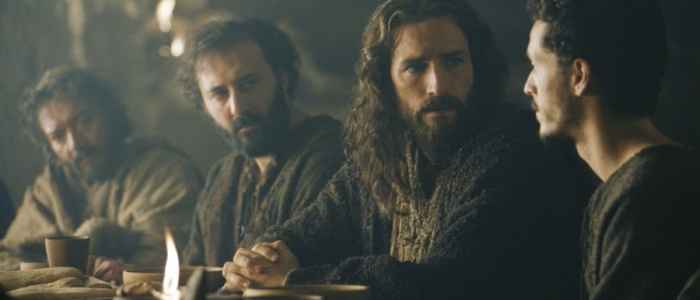
The film also appeals to the humanity of Jesus. Where other adaptations saw him as beyond the fear that a human would in fact feel when faced with death, Gibson shows Jesus feeling actual fear. Gibson’s Jesus is a man, a human like us. He struggles to overcome the torture and accept God’s plan. Jesus has doubts and fears as every human feels. There are many moments throughout the film where Jesus experiences doubt, and psychological and emotional suffering. These scenes convey a more compelling image of a hero, and Jesus’ immense will and strength to do what he knows is right.
The film begins with his temptation in a very compelling scene, in which Satan appears and asks him who his father is. Jesus continues to pray for strength to do what he knows is right, as we see Satan’s serpent slithering closer to him. The audience can see that Jesus is weakened by fear, for he knows the pain that he will have to experience.
The sky is dark, and the foreboding rays of the moon, mysterious and ethereal, light the visage of Jesus, as if he is between two worlds. Jesus is feeling the weight of the oppressive fear, he knows he cannot escape his purpose. Caviezel is sweating profusely—he is crying and praying in frantic and desperate spurts. You can see through Caviezel’s acting that Jesus is profoundly frightened. In the film, one of the apostles asks what he is doing, to which the apostle Peter responds “I think he is afraid.” This is a side of Jesus not normally seen in cinema—he is the more human Jesus. Faced with the ultimate sin and his impending death, audiences can see and relate to this desperate time. Gibson shows Jesus is reacting to immense pressure with intense fear and uncertainty, which is something all humans feel when we are faced with an obstacle that makes us uncertain of our own future. We feel his every emotion, and this makes his sacrifice all the more compelling and personal.

However, after the encounter with Satan and Jesus’ arrest, the film becomes extremely graphic and has intense visual violence, centered around his physical torture. The viewer witnesses in graphic detail all of the pain that Jesus experiences, as if Gibson himself is nailing the torture and suffering to our eyes. This transition from the psychological temptation to
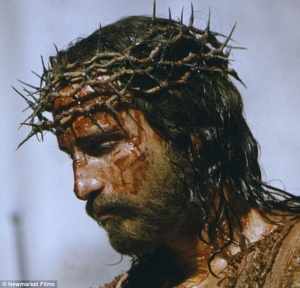
physical torture makes Jesus and his experience all the more real, which makes the impact of his sacrifice all the more lasting. It is especially difficult to see the torture as someone who idolizes Jesus completely, but through visually experiencing the torture he went through, the viewer is changed. The viewer, through visual stimulation, can see the pain Jesus experiences. Gibson makes the eyes of the viewer an altar, and the sacrifice of Jesus is displayed before the eyes. Therefore, Gibson creates a bond with the viewer, for we are witnessing in gruesome detail the paintful, final 12 hours of Jesus’ life. It becomes more intimate, and makes him less of a God and more of a man, forcing our sympathy.
Gibson ends the film with his resurrection, so it is not completely wrought with violent torture. The viewer sees Jesus live again, which makes Gibson’s ending more hopeful. But it is never a comfortable experience to witness your hero die, and even though it follows with a resurrection, the experience of viewing the film can be difficult. But regardless, it is the human condition to have a hero, Christian or otherwise, overcome fear and doubt, even death itself. A figure of hope, or a Christ figure, represents a utopian future, nourishing our need for hope and awakening the soul to act. This gives the viewer strength when they witness another rise up when they are in doubt. This relates to the reason why Jesus was created, and lived humbly as a man: to allow humanity to be able to identify with him. The Passion of the Christ has been criticized heavily for many reasons, mainly for its violence, which many critics saw as taking away from the true meaning of Jesus and his sacrifice. But however harsh the criticism, the film did extremely well. It made over $600 million during its theatrical release, becoming the highest grossing R-rated film in the United States, and the highest grossing non-English-language film of all time. It can be argued that the success of this film is largely attributed to its intense realism and faith to the ideals that Jesus represents. Even though The Passion of the Christ was dominated by violence, it ends with his resurrection, which captures the idea of the destiny of humanity and a higher purpose after death.
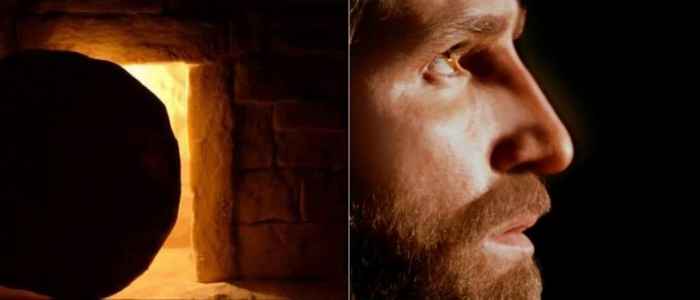
The Christ figure itself has been an ever present companion to the characteristics of heroes in many stories and films. The Christ figure and the sacrificial hero is an essential figure of hope in many stories throughout the ages, and there are frequent instances in stories and film that a Christ figure is represented. The story of Jesus has been adapted time and again, as he represents the ideal hero that humankind can strive for. But there are other heroes who have emerged throughout time that can be argued as another representation of the Christ figure—namely, superheroes.
Superman: the Sacrificial Hero in Man of Steel
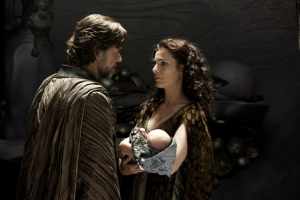
In Man of Steel, the origins of the superhero Superman, played by Henry Cavill, is depicted. The film opens with the planet Krypton facing unavoidable destruction because of its unstable core. Scientist Jor-El and his wife Lara launch their newborn son Kal-El, the first naturally born Kryptonian child in centuries, to earth after infusing the codex of the entire Kryptonian race into his cells. Kal-El’s ship lands in Kansas. He is raised by Jonathan and Martha Kent, who name him Clark. On earth, Clark gains superhuman powers, and is warned by his adopted father not to use them for fear that society would reject him. After Jonathan’s death, Clark spends several years in hiding, afraid to show the world his true power. But he is forced to come out of hiding when Zod and his followers, exiled from Krypton when they attempted a coup, threatens the destruction of Earth. After Clark gives himself up to the hands of his enemies, he learns of their true intentions: to re-build Krypton over the destroyed earth. At the end of the film, Superman saves the world at great cost, but vows to continue to save earth in his lifetime.
Superman is one of the most lasting icons of our modern popular culture, mainly because he is a deified version of ourselves. Superman represents a utopian ideal—the idea that humanity can be united by a single hero, who sacrifices himself to save us. In this utopian, perfect world, humanity can live under the protection of a virtuous and selfless hero. Because he came from a dying world with the purpose of making earth a better place, Superman has the ideal qualities that humanity needs in a hero. Like the Christ figure, Superman is using his humanity as a strength, while maintaining that he is in a sense “divine,” because he is from a world beyond our own.
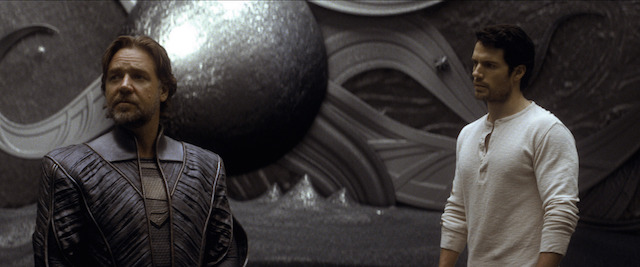
The fact that he emerged from a world far more advanced than ours, but seeks to make ours better through the knowledge of the mistakes Krypton made, makes him a stronger hero. He is taking the best of both worlds literally, giving humanity an ideal to strive towards. For example, Jor-El’s consciousness speaks with Clark in the beginning of the film, explaining his origins and the reason why he was sent to Earth. Jor-El says: “You will give the people of Earth an ideal to strive towards. They will race behind you, they will stumble, they will fall. But in time, they will join you in the sun, Kal. In time, you will help them accomplish wonders.” Jor-El is telling Clark that he will lead humanity to salvation, and help create a better world. Jor-El is explaining that Clark will stand for humanity, and become a figure for the utopian ideal of hope. The “S” on his uniform is confused as being simply the letter “S,” when in fact it actually means “hope” in the Kryptonian world. Even his uniform means “hope,” further conveying the ideal that Superman represents.
Parallels Between Jesus and Superman
Humanity looks to Christ figures and heroes like Jesus and Superman in times when we are in need of a hero to carry our burdens for our salvation. The fact that the stories of Superman and Jesus have been re-told and adapted frequently, speaks to our need for a sacrificial hero in troubled times in history. The timing of the release of The Passion of the Christ was significant as well. It was released in 2004, and Superman Returns, another film with the character Superman, was released in 2006, when the United States was still recovering from 9/11, and deeply involved in the “War on Terror.” This war has had lasting impacts on our country as we continue to fear terrorist attacks. The war has had uncertain outcomes, and developed a more uncertain purpose in the recent years. The creators of the films must have felt that society needed to be reminded of the utopia that Jesus represents, and that he died for a better world. We were in need of a figure of hope during this crisis that was occurring around us, and to be reminded that America stands for that utopia. Because these heroes are so willing to give their lives for others, the creators of the films wanted us to hold onto that American value of saving people in their time of need.
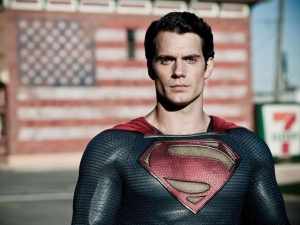
When Man of Steel was released, the world was going through uncertain times as well. To name a few world events that occurred before the release of Man of Steel, the 9.0 magnitude earthquake occurred in 2011 in Tohoku, Japan, and Hurricane Sandy in October 2012. These were disasters caused by nature, which is always an unpredictable and uncertain power on our earth. From observation, because of the increase of technology, we lost a bit of our sense of personal connection with one another as a race. During these times, we were longing for a figure to lead us to salvation and unity among one another. In all of the time periods that these films were released, humanity was in desperate need of rescue, and we needed heroes to believe in.
His purpose as standing before humankind and leading us to salvation is one of the many ways that Superman can be paralleled to the Christ figure. Superman’s name in itself is a direct allusion. The name “El” comes from a root word in the Hebrew scripture meaning “God.” Because Kal-El is son of Jor-El, he is the son of God. Like Jesus, Clark also experiences extreme apprehension before becoming Superman. When Lois Lane discovers that Clark is the “mystery man” that saved her in the cave, she asks him to let her tell his story. Clark replies by saying, “My father told me that if the world found out who I really was, they’d reject me…out of fear. I let my father die because I trusted him. Because he was convinced that I had to wait. That the world was not ready. What do you think?” This can be paralleled to what happened when Jesus reveals that he is the Son of God in the Bible. Jesus is met with hostility and is condemned by his own people—rejected because they fear him. Clark is afraid that the world was not ready to see someone supernatural rising before them to save the Earth because they would fear him. When Superman does come out of hiding, it is because Zod threatens to harm humanity. In a

later scene in the film, Clark is sitting in a church and begins to talk with a priest, feeling real human weakness. His eyes are lowered in prayer, and his thoughts are tortured, for he knows that he is the only one who can stop the destruction of humankind. As the viewer witnesses these private moments, the tormened thoughts of Superman, this makes his character like Gibson’s Jesus. During this scene, Clark seems less like a God and more like a man. He asks the priest if there is a chance to save earth by giving himself up to Zod. Clark says, “Zod can’t be trusted. The problem is, I’m not sure the people of earth can be either,” he begins to walk away. The priest, seemingly being elevated by the presence of Superman, responds by saying, “Sometimes, you have to take a leap of faith first. The trust part comes later.” This can also be paralleled with Jesus, because his faith in humankind is what drives him to his ultimate sacrifice, and he takes a leap of faith, trusting in God. Jesus knows that humanity will condemn him, but after his death and resurrection, they finally recognize him as the Son of God. Jesus had to take this leap of faith in order to earn the trust and faith from humanity. After Superman saves the Earth from Zod at great cost, after he takes this leap of faith, humanity finally trusts him.
These Christ figures, Jesus and Superman, seem to be moving effortlessly thought time. The Christ figure has given our society a hope and an ideal to strive for. These specific heroes have dominated our cinemas, inspiring generations to strive for a better world. This ideal is representative of a utopian future that we cannot help but imagine being possible. There will always be conflict, there will always be injustice—but believing in something greater than yourself, a higher version of yourself, a being, or a superhero, will motivate us to try to make the world a better place. We are consistently motivated by these examples, and they are the fuel to the fire which brightens the world around us. The heroes of Jesus and Superman represent an ideal, and the world is saved by their willingness to give their lives for humanity.
Works Cited
“Crazy Credits.” IMDb. IMDb.com, n.d. <http://www.imdb.com/title/tt0335345/trivia?tab=cz&ref_=tt_trv_cc>.
Man of Steel. Dir. Zack Snyder. Perf. Henry Cavill, Russel Crowe, Amy Adams, Diane Lane. Warner Bros, 2013.
“The Bible in Pop Culture. (cover story).” Time 169.14 (2007): 44-45.
The Passion of the Christ. Dir. Mel Gibson. Perf. Jim Caviezel. Icon Productions, 2004.
What do you think? Leave a comment.











Gibson’s film was almost exactly how the trial and execution of Jesus was described to us at school and in church when I was little.
I agree, it was very true to the suffering Jesus did experience in the Gospels and in Catholic tradition in particular.
This gives me an excuse to call for a remake of “Prince of Darkness”, where John Carpenter reconciles science and religion. I was freaked out by that movie as a little dude.
I have never seen Prince of Darkness, but I am interested by the reconciliation between science and religion point!
Superheroes all tend to have some kind of messiah complex. It’s what makes them superheroes. In this case, the Christian iconography is used as a literal theme instead of an allusion.
I agree, I am very fascinated by the messiah complex and I think it is important in building the superhero as a powerful and compelling character.
I’m so glad to see this got published! Great article!
Thank you so much Dominic, I appreciate it!
Superman as a character has always stood as a Christ figure. Man of Steel focused on that and included visual themes to add to the character parallels: Superman falling out to space with his arms spread wide as if he were on a cross and having his revelation of faith in a church with a priest being prime examples. Some critics of Man of Steel often bemoan these scenes, but I always liked the Christ-figure side of Superman.
Very true, and I think the Christ-figure side of Superman is part of what makes his character so compelling and so moving!
Christ is understandably linked to religion but I actually think he transcends it. You don’t have to subscribe to a religious belief system in order to believe, like I do, that Jesus existed and that his messages about peace, tolerance and forgiveness were for the good of mankind.
I agree, that is a very good point, I totally respect that. His messages transcend religion.
Superman = made up character.
Jesus = made up character.
Similarities have been noted.
Remarkable summary.
Too bad Superman is supposed to be Moses.
Jesus Christ is unique in that he used his powers strictly in non violent means. We still see a definitive lack of that in our superpowered heroes today. I’m not a religious person by any means but I still find this non violent aspect of Jesus’s mythology to be inspiring.
Yes, Jesus is unique because he was a reformer, very inspiring.
That shot of Supes flying back from Jor-el in a crucifixion pose. I said “Oh Boy…. there it is.”
🙂
The passion was one of the greatest films I have ever seen. People who go on about the violence are talking nonsense and are using it to cover their anti christian views.
Indeed, The Passion is an incredible film!
Only begotten son sent to Earth to save us all?
I like the idea of Supes being Moses more… it makes for a more interesting long-term Superman story. But I don’t really care what religious iconography or themes they decide to play with provided the movie itself makes for a good time… and it certainly does that.
I love that this subject matter has been addressed! It is interesting to examine the messianic hero throughout all literature and film.
Great article!
Thank you very much for your comment, I am hoping to expand on the idea of a messianic hero in the future so stay tuned! 🙂
Very interesting read. Your article not only makes me think of how Superman is symbolic to Jesus Christ, but just how often films use Jesus metaphors a lot for main characters. Neo from The Matrix and Murphy for Robocop are the first ones to come to mind. I personally feel that using Jesus metaphors in films can work, as long as the film is not beating the audience over the head with rather unsubtle symbolism.
Thank you Aaron, you are too kind. My fascination with the Christ figure in film stemmed from observing Neo in The Matrix, so we have a similar train of thought! 🙂
As a Superman nerd I feel compelled to read far more reviews of the movie than I really need to.
Duh, of course it’s all about Jesus.
I’m a Christian, and honestly I’m sick of everyone trying to turn their character into Jesus (LotR’s Aragorn, Aslan from Narnia, etc.). I don’t find it really insulting to Jesus as I do it’s insulting to me. It’s like if someone knew I liked steak, and gave me some Burger King and said that since they have similar qualities, they’re on the same level. They’re not.
I like Superman. I really do, but I literally worship Jesus. Don’t degrade my savior by bringing him to the level of a fictional comic book character.
You are entitled to your feelings and your opinion. I am a Christian, therefore my intentions are certainly not to “degrade” Jesus. My intentions are the opposite, in fact: I am acknowledging the power of the Christ figure. What I have done is demonstrate the power that the messianic figure still has on humanity and popular culture. And humans have done this with messianic figures throughout our history in art, writings, etc. Now it is done through film.
The concept of Superman and Jesus is something that is interesting and intriguing at the same time.
Man of Steel draws on the “moral influence” theory of atonement, exemplified in the writings of medieval theologian Peter Abelard, rather than the better known substitutionary version of atonement offered by Abelard’s contemporary, Anselm.
According to Abelard, Jesus’ heroic self-sacrifice on the cross reveals God’s love for humanity and inspires them to love and obey him in return. As Abelard argued that Jesus’ action showed people how to live in loving obedience to God, so Jor-El believes that Kal-El will become humanity’s great moral exemplar, leading them to new heights of achievement.
Jor-El hopes that his son will inspire humanity to choose good rather than evil. The moral development of humanity will require a process of growth and maturation. Kal-El offers his son this mission: “You will give the people of earth an ideal to strive towards. They will race behind you. They will stumble; they will fall. But, in time, they will join you in the sun, Kal. In time, you will help them accomplish wonders.”
This is by far one of the most interesting articles I have read regarding the similarities between Jesus Christ and Superman. I actually really liked that you only withdrew the Jesus from The Passion and the Superman from Man of Steel. It limits the vast characterization both figures have received over the many years they have been around. It gives limits to both characters and allows the reader to fully form their own opinion with the knowledge they have simply from watching these widely seen movies. There is so much more to learn about Superman from the comics and just as much if not more to learn about Jesus from the Bible both Old and New Testament.
My favorite part of the article had to be the connection between the names of Kal-El, Jor-El and “El” the hebrew word meaning God. This was a very interesting connection that I had not thought of before and definitely brought the relation between the two closer than I had previously imagined. Thanks for sharing your thoughts! I definitely look forward to more articles!
Thank you so much, you are too kind! I am definitely passionate about this topic and I hope to write more about it. I greatly appreciate your comment, I am so glad you enjoyed my article. 🙂
I have long been fascinated with the character of Superman – from dreaming of the ability to fly to becoming aware of how kryptonite can be a symbol of sin. Like it or not, Mel Gibson’s portrayal of the beating and crucifixtion of Jesus in “The Passion of the Christ” is not even close to the reality of the anguish of Jesus carrying the sin of the world.
It is really cool that the connection can be made between Jor-El and Kal-El, father and son, and the Lord and Jesus, father and son. Each of the fathers send their son to earth, the Lord specifically to save humanity, Jor-El specifically to save his son. So, with two different intentions but yet both choose to save mankind.
Also, I like how you touched on the fact that it is the humanistic quality of both ‘characters’ that draw believers and fans. Both Jesus and Superman go through a inner dilemma of whether or not to become the beings they were born to be. Their choice to turn away from fear and cowardice is why we are drawn to them, a sense of bravery and selflessness we all hope to harbor and convey.
Thank you very much for your kind comment, and the difference between the father your noted. I really appreciate it! 🙂
I have seen things done about showing the links between God characters, but I haven’t really seen anything on Jesus characters. This is a correlation that seems obvious now that it’s been pointed out, but I have to admit I have never linked the two before. Nice article.
Thank you so much, you are so kind! 🙂
This is an incredible article. The parallels you pointed out between The Passion’s Jesus and Man of Steel’s Superman are striking. I think it’s even mentioned in Man of Steel that Clark is 33, which is the same age Jesus was when he was crucified. Plus there’s the iconic scene of Kal doing the crucifix pose in space.
I hadn’t even thought about the timing of release for The Passion and Superman Returns. It makes sense that these came out shortly after the 9/11 attacks. I’d argue Returns has an even stronger representation of Christ (check out the scene between Clark and Lois floating in the clouds), but Man of Steel is still a beautiful vision of the Son of God and the Son of Man.
Well done! Looking forward to reading more from you.
Thank you so much for your kind words! 🙂 and well spotted with the different ages, 33 also invokes the Trinity, which is yet another connection that can be made.
Great, compelling article. I always saw Superman as more of a Moses figure than Jesus, but Man of Steel without a doubt evokes Christ imagery and parallels.
Nice article. Man of Steel is one of my favorite films, and Superman one of my favorite heroes, because of the parallel he has with Christ. That Superman is an ideal who leads through sacrifice is perhaps one of the more prominent christian themes of the film. You hit the nail on the head.
I’ve participate of the lectures of John X Evans at ND University about heroism in Western tradition. Your work match a lot with the goals of these studies.
Your assumption is correct for reasons as such:
1 – the very ideal of heroism for western civilization (and to speak of “globalized world” mens almost the same of “westernized world”) that comes to us in modern times is plenty of christian ideals of salvation and virtue;
2 – the need of a hero is not only about some kind of salvation, but one specific, which is salvation by virtue and truth.
3 – the virtue that Jesus have shown (what he discovered trought his very life) is a path of self and individual salvation of all; and that’s why a christian superman cannot use his power to control everybody for a better world (like in “superman; red son”), because a better world is only possiblie when everyone has the individual commitment with the necessary virtues to be (not a matter of building, but “being”) this “better world”.
So, the very ideal of heroism in modern times is all about exemplarity to build individual virtue in everybody and then the salvation comes as a consequence of it (the individuality commitment to perfection that christian god wants from each one of us, this is the very reason, justification and foundation of individualism in modern times).
Interesting comparison. A thoughtful essay.